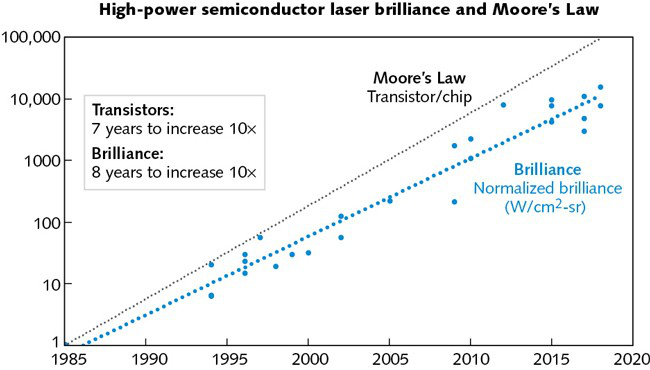
Moore conceived of "fixing more components to the integrated circuit" - then, the number of transistors per chip increased by 10 times every 7 years. Coincidentally, high-power semiconductor lasers incorporate more photons into the fiber at similar exponential rates (see Figure 1).

Figure 1. Brightness of high-power semiconductor lasers and comparison with Moore's law
The improvement in brightness of high power semiconductor lasers has promoted the development of various unforeseen technologies. Although the continuation of this trend requires more innovation, there is reason to believe that the innovation of semiconductor laser technology is far from being completed. The well-known physics can further improve the performance of semiconductor lasers through continuous technological development.
For example, quantum dot gain media can significantly increase efficiency compared to current quantum well devices. Slow axis brightness offers another order of magnitude improvement potential. New packaging materials with improved thermal and expansion matching will provide the enhancements needed for continuous power adjustment and simplified thermal management. These key developments will provide a roadmap for the development of high power semiconductor lasers in the coming decades.
Diode-pumped solid-state and fiber lasers
Improvements in high-power semiconductor lasers have made the development of downstream laser technologies possible; in the downstream laser technologies, semiconductor lasers are used to excite (pump) doped crystals (diode-pumped solid-state lasers) or doped fibers (fiber lasers).
Although semiconductor lasers provide high-efficiency, low-cost laser energy, there are two key limitations: they do not store energy and their brightness is limited. Basically these two lasers need to be used for many applications: one for converting electricity into laser emission and the other for enhancing the brightness of the laser emission.
Diode-pumped solid-state lasers. In the late 1980s, the use of semiconductor lasers to pump solid-state lasers began to gain popularity in commercial applications. Diode-pumped solid-state lasers (DPSSL) greatly reduce the size and complexity of thermal management systems (mainly recirculating coolers) and obtain modules that have historically combined arc lamps for pumping solid-state laser crystals.
The wavelengths of the semiconductor lasers are selected based on their overlap with the spectral absorption properties of the solid-state laser gain medium; the heat load is greatly reduced compared to the wide-band emission spectrum of the arc lamp. Due to the popularity of 1064 nm germanium-based lasers, the 808 nm pump wavelength has become the largest wavelength in semiconductor lasers for more than 20 years.
With the increase in the brightness of multimode semiconductor lasers and the ability to stabilize the narrow emitter line width with volume Bragg gratings (VBGs) in mid-2000, the second generation of improved diode pumping efficiency was achieved. The weaker and spectrally narrow absorption features around 880 nm have become hot spots for high brightness pump diodes. These diodes can achieve spectral stability. These higher-performance lasers can directly excite the laser‘s upper level 4F3/2 in silicon, reducing quantum defects, thereby improving the extraction of higher-average fundamental modes that would otherwise be limited by thermal lenses.
By the beginning of 2010, we have witnessed the high-power scaling trend of the single-cross-mode 1064nm laser and related series of frequency conversion lasers operating in the visible and ultraviolet bands. Due to the longer high energy state lifetimes of Nd:YAG and Nd:YVO4, these DPSSL Q switching operations provide high pulse energy and peak power, making them ideal for ablative material processing and high precision micromachining applications.
fiber-optic laser. Fiber lasers provide a more efficient way of converting the brightness of high power semiconductor lasers. Although wavelength-multiplexed optics can convert a relatively low-luminance semiconductor laser into a brighter semiconductor laser, this is at the expense of increased spectral width and optomechanical complexity. Fiber lasers have been shown to be particularly effective in photometric conversion.
The double-clad fibers introduced in the 1990s use single-mode fibers surrounded by a multimode cladding, enabling higher-power, lower-cost multimode semiconductor-pumped lasers to be efficiently injected into the fiber, creating a more An economical way to convert a high power semiconductor laser into a brighter laser. For ytterbium (Yb) doped fibers, the pump excites a broad absorption centered at 915 nm or a narrow band feature around 976 nm. As the pump wavelength approaches the lasing wavelength of the fiber laser, so-called quantum defects are reduced, thereby maximizing efficiency and minimizing the amount of heat dissipation.
Both fiber lasers and diode-pumped solid-state lasers rely on improvements in diode laser brightness. In general, as the brightness of diode lasers continues to improve, the proportion of laser power that they pump is also increasing. The increased brightness of semiconductor lasers facilitates more efficient brightness conversion.
As we would expect, spatial and spectral brightness will be necessary for future systems, which will enable low quantum defect pumping with narrow absorption characteristics in solid-state lasers and dense wavelength multiplexing for direct semiconductor laser applications. The plan becomes possible.
Market and Application
The development of high power semiconductor lasers has made many important applications possible. These lasers have replaced many traditional technologies and have implemented new product categories.
With a 10-fold increase in cost and performance per decade, high-power semiconductor lasers disrupt the normal operation of the market in unpredictable ways. Although it is difficult to accurately predict future applications, it is very significant to review the development history of the past three decades and provide framework possibilities for the development of the next decade (see Figure 2).

Figure 2. High-power semiconductor laser brightness fuel application (standardization cost per watt brightness)
1980s: Optical storage and initial niche applications. Optical storage is the first large-scale application in the semiconductor laser industry. Shortly after Hall first showed the infrared semiconductor laser, General Electrics Nick Holonyak also showed the first visible red semiconductor laser. Twenty years later, compact discs (CDs) were introduced to the market, followed by the optical storage market.
The constant innovation of semiconductor laser technology has led to the development of optical storage technologies such as digital versatile disc (DVD) and Blu-ray Disc (BD). This is the first big market for semiconductor lasers, but generally modest power levels limit other applications to relatively small niche markets such as thermal printing, medical applications, and selected aerospace and defense applications.
The 1990s: Optical networks are prevailing. In the 1990s, semiconductor lasers became the key to communication networks. Semiconductor lasers are used to transmit signals over fiber optic networks, but higher power single mode pump lasers for optical amplifiers are critical to achieving scale of optical networks and truly supporting the growth of Internet data.
The telecommunication industry boom brought by it is far-reaching, taking Spectra Diode Labs (SDL), one of the first pioneers in the high power semiconductor laser industry as an example. Founded in 1983, SDL is a joint venture between the Newport Group's laser brands Spectra-Physics and Xerox. It was launched in 1995 with a market capitalization of approximately $100 million. Five years later, SDL was sold to JDSU for more than $40 billion during the telecom industry peak, one of the largest technology acquisitions in history. Soon after, the telecommunications bubble burst and destroyed trillions of dollars of capital, now seen as the biggest bubble in history.
2000s: Lasers became a tool. Although the bursting of the telecommunications market bubble is extremely destructive, the huge investment in high-power semiconductor lasers has laid the foundation for wider adoption. As performance and cost increase, these lasers are beginning to replace traditional gas lasers or other energy conversion sources in a variety of processes.
Semiconductor lasers have become a widely used tool. Industrial applications range from traditional manufacturing processes such as cutting and soldering to new advanced manufacturing technologies such as additive manufacturing of 3D printed metal parts. Micro-manufacturing applications are more diverse, as key products such as smartphones have been commercialized with these lasers. Aerospace and defense applications involve a wide range of mission-critical applications and will likely include next-generation directional energy systems in the future.
to sum up
More than 50 years ago, Moore did not propose a new basic law of physics, but made great improvements to the integrated circuits that were first studied ten years ago. His prophecy lasted for decades and brought with it a series of disruptive innovations that were unthinkable in 1965.
When Hall demonstrated semiconductor lasers more than 50 years ago, it triggered a technological revolution. As with Moore's Law, no one can predict the high-speed development that high-intensity semiconductor lasers achieved by a large number of innovations will subsequently undergo.
There is no fundamental rule in physics to control these technological improvements, but continuous technological advancement may advance the laser in terms of brightness. This trend will continue to replace traditional technologies, thus further changing the way things are developed. More important to economic growth, high-power semiconductor lasers will also promote the birth of new things.
Copyright @ 2020 Shenzhen Box Optronics Technology Co., Ltd. - China Fiber Optic Modules, Fiber Coupled Lasers Manufacturers, Laser Components Suppliers All Rights Reserved.